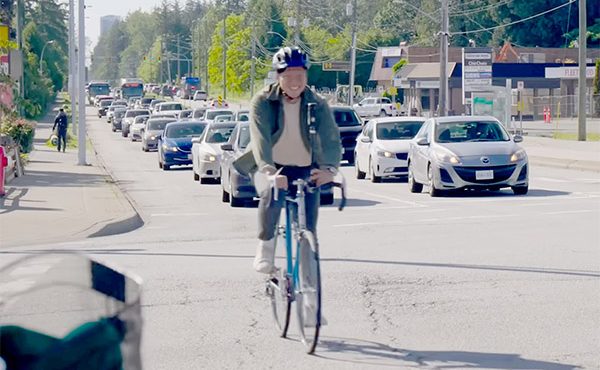

The Vancouver Urban Forum held at the Vancouver Playhouse yesterday brought together minds focused on urbanity to discuss and present ideas regarding the future of Vancouver, and cities in general. Presented by the Global Civic Policy Society and its founder, former Vancouver mayor Sam Sullivan, the series of talks on the city was well attended, nearly filling the theatre. Some two dozen presenters and panelists discussed what will shape the next wave of urbanization, development, and civic politics.
Spacing Vancouver’s Brendan Hurley and Yuri Artibise were there, taking voracious notes and tweeting like mad men. Many concepts and theories were posited at the Playhouse and many more are still needing to be processed by the Spacing Team–look forward to future Indepth Features on some of the more intriguing talks and topics brought up.
A number of reoccurring concepts, however, seemed to be prominently featured in the many presenters’ discussions:
First, was a general and repeated call by many on stage for “A New Deal for Cities”. Beyond just a change in political actors and decisions, the demand was for a change in the underpinning structural makeup of political decision-making and power distribution. Even at the Federal level, the distribution of parliamentary seats and debate tends to be lopsided towards rural needs and places despite the opposite being demographically true. A level of autonomy not afforded by the Canadian constitution–where cities are treated as a “creature of the provinces” and legally exist with powers at provincial leisure–was demanded to allow cities to be an emboldened and responsive shaper of their supporting regions, environments, and economies.
An additional underlying concept focused around the perceptions and functions of density in cities. Density is often seen as a derisive word, one that causes feelings of fear for the loss of held values of what life should be. The need to accept the inevitability influx of people to this city—and cities in general—was expressed. There was no prescribed form, however. It’s not about fitting people into urban areas by any means necessary; it’s about finding the right tools and systems to support the lives of these people so that they can live happy, healthy and engaged lives as urban citizens.
“It’s not the density; it’s the design” as Redwood City, CA planner Dan Zack proclaimed. The gleaming Vancouverist towers of James Cheng are a possible tool, but so are strategies of “gentle density” as presented by former planning director Brent Toderian. Patrick Condon’s call for rational urban structure “that runs on itself” focuses the impacts and experiences of urban development. Making public life and human-scale movement the pleasurable, even magical, “spice of life” in cities “for everyone” was the necessity attested by the infectiously enthusiastic Gil (Guillermo) Peñalosa, of 8-80 Cities.
Another common theme expressed emphasized the city as confluence and reciprocal generator of ideas and thinkers. This was proclaimed by Edward Glaeser, author of Triumph Of The City, and served to underpin the concepts of civic culture and urban competitiveness presented by many others. Cities, as understood throughout this event, are the interplay of ideas of density and in turn a density of ideas. The value of urban culture is that it brings us together and pronounces our differences, makes problems and solutions present, and, as architect Matthew Soules counter intuitively suggests, provides perpetual conflict that makes humans more productively peaceful.

The flipside of the coin is the fact that sprawl still pervades our system of development. As the event took place, a “Sprawl Meter” ticked away quantifying the square feet that were estimated to be expanded into undeveloped land in the region. Vancouver’s dirty secret “that is not spoken about in polite company”, as Lance Berelowitz quipped, is that the City, despite the international branding of and focus on Vancouverism, is still part of a suburban development system that is very similarly to the rest of North America.
Despite a few key developments there is still a dichotomy in Vancouver of a towered, high-density core and ‘protected’ single family homes. The hope is for more options to be provided in these suburban neighbourhoods – especially those within the City of Vancouver itself – as we move forward on the project of the city.
Gordon Price made a call for the audience to place this kind of event into contexts beyond talking amongst ourselves and preaching to the regular pro-urbanist congregation. These concepts and arguments need to be brought to the ‘real’ decision makers in the region –the Port, BCAA, YVR, and federal and provincial transportation bodies– that continue to push for a “motordom” option that was proven obsolete with the previous 3rd wave of urban development that stopped the freeways in the 1970s.
Yet the sprawl counter ticked on, and by the end of the 8.5 hours of presentations, it was up to 240,000 square feet— 2 typical Vancouver blocks (streets and lanes included).

***
Brendan Hurley is a local urban designer who focuses on planning for adaptive neighbourhood change. His recent work has been internationally focused, but is strongly rooted in his native Vancouver. Living and working out of the heart of downtown, he remains keenly focused on the region’s development and history. Brendan is acting as Assistant Editor of Spacing Vancouver, but also consults as director of the UrbanCondition design collective.


